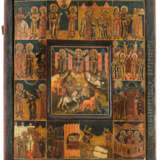ID 121633
Lot 1003 | SELTENE UND MONUMENTALE VITA-IKONE DER HEILIGEN FLORUS UND LAURUS
Verbund zweier Bretter mit zwei profilierten Rückseiten-Sponki. Kowtscheg, Eitempera, Kreidegrund, partielle Vergoldung. 70,5 x 57 cm. Im Zentrum der Komposition Bildfeld mit der ganzfigurigen Darstellung des Erzengels Michael, der Pferde an der Longe hält, um sie den beiden Heiligen zu übergeben vor einer stilisierten Architekturlandschaft. Zu beiden Seiten rahmen ihn der bärtige Florus links und der jugendliche Laurus rechts. Im unteren Bereich in felisger Landschaft mit spärlichem Pflanzenbewuchs Darstellung von drei Reitern, die Pferde zur Tränke führen. Feine Modellierung der Gesichtszüge. Entlang des Randes reihen sich zwölf Felder, die das Leben der Heiligen thematisieren. Die heiligen Zwillingsbrüder Florus und Laurus lebten Anfang des 2. Jahrhunderts in Illyrien und erlitten unter Kaiser Hadrian ihr Martyrium. Von Beruf Steinmetz, erlernten sie auf wundersame Weise das Reiten von dem Engel des Herrn. Der Kult der Heiligen ist seit dem 12. Jahrhundert in Russland belegt. Als Viehpatrone wurden sie vornehmlich bei Tierseuchen angerufen. Insbesondere gelten sie als Beschützer der Pferde. In der Ikonographie dieses Ikonenthemas wurde das Wunder von Florus
und Laurus mit der Vita der heiligen Drillingsbrüder Eleusippus, Speusippus und Meleusippus verwoben. Diese lebten im 3. Jahrhundert in Kappadokien las Pferdehirten und erlitten unter Aurelius den Opfertod. Min. Farbabsplitterungen, min. Einstimmungen.
| Auction house category: | Russian and Greek icons |
|---|
| Auction house category: | Russian and Greek icons |
|---|
| Address of auction |
Hargesheimer Kunstauktionen Düsseldorf Friedrich-Ebert-Strasse 11+12 40210 Düsseldorf Germany | ||||||||||||||
|---|---|---|---|---|---|---|---|---|---|---|---|---|---|---|---|
| Preview |
| ||||||||||||||
| Phone | +49 (0) 2113020010 | ||||||||||||||
| Fax | +49 (0) 21130200119 | ||||||||||||||
| Buyer Premium | 28.56% | ||||||||||||||
| Conditions of purchase | Conditions of purchase | ||||||||||||||
| Shipping |
Postal service pickup by yourself | ||||||||||||||
| Payment methods |
Wire Transfer | ||||||||||||||
| Business hours | Business hours
|




